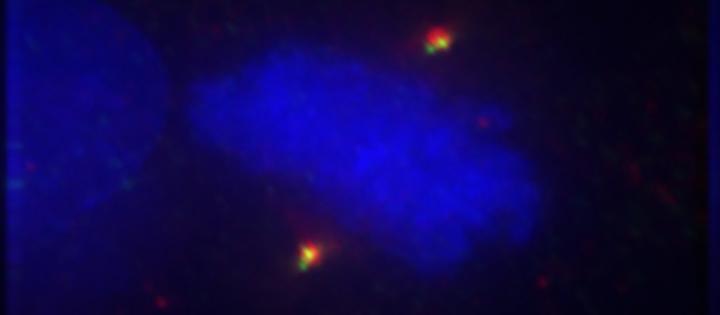New chemical weapon to combat cancer

Multipolar melanoma cells stained for centrosomes (gamma-tubulin in red, centrin in green) and DNA (DAPI in blue). Scale bar represents 5 μm. Credit. © UNIGE
The fight against cancer involves eradicating cancer cells but current treatments inevitably have negative consequences on healthy cells. Patients often develop a resistance to the drugs and suffer from side effects due to the doses used in the treatments. How can this two-fold problem be managed?
Scientists from the University of Geneva (UNIGE), Switzerland, analysed 200 combinations of different anti-tumour drugs in an attempt to reduce the doses. They employed a new technique to test the impact of a combination on a cancer cell and healthy cell simultaneously.
The researchers discovered a highly promising mix of four components, called C2, that can kill tumour cells while leaving healthy cells undamaged. You can read about these very hopeful results in the journal Cancers.
The drugs that attack tumours have to be aggressive for them to be effective. The balance between destroying cancer cells and the collateral damage inflicted on healthy cells is, however, a constant challenge. High doses of an anti-cancer drug can cause two main types of damage: progressive resistance to the drugs as the body acclimatises to the massive doses; and unwanted side effects on the patient's healthy cells.
How, then, can we combat cancer without harming the patient? “The main objective is to reduce the doses of the drugs so we can avoid resistance”, explains Patrycja Nowak-Sliwinska, a professor in the Institute of Pharmaceutical Sciences of Western Switzerland and at UNIGE and in the university's Translational Research Centre in Onco-Haematology (CRTOH). “That's why we're creating new formulas made up of several low-dose treatments that will help us achieve our goal without inducing any resistance.”
Testing new formulas simultaneously
The UNIGE researchers focused on ten substances used to fight cancer, producing some 200 possible combinations. “We used a method we developed in our laboratory to test these different combinations simultaneously in vitro on a cancer cell and on a healthy cell. The aim was to directly compare the effects of the treatment on the two types of cells”, continues professor Nowak-Sliwinska. “We were able to eliminate the formulas that didn't destroy the diseased cells together with those that also had an impact on the healthy cells.”
Thanks to this simultaneous validation technique, the UNIGE researchers identified the most effective combinations with the fewest possible side effects on healthy cells, with one in particular standing out: C2.
Highly promising new cancer treatment
C2 – which consists of four products (tubacin, CI-994, erlotinib and dasatinib) – is developing a new and highly promising mechanism of action. “During our in vitro tests, we found that C2 killed up to 20 times more cancer cells than other combinations, while sparing healthy cells”, explains Patrick Meraldi, a professor in the Department of Cellular Physiology and Metabolism in UNIGE's Faculty of Medicine and at the CRTOH.
The special characteristic of C2 is that it targets the supernumerary centrosomes that are only found in tumour cells. “Each cell is equipped with two centrosomes, organelles that allow it to divide in two by each 'pulling' one half of the cell”, explains professor Meraldi. As for the cancer cells, they have more centrosomes that tug the cell in three or four directions during its division, which leads to cell death.
To prevent this, the cancer cells group the centrosomes into two poles. “C2 blocks the grouping, causing a cell death specific to the tumour cells with supernumerary centrosomes, while leaving the healthy cells unharmed”, continues the Geneva-based researcher.
There is a drug currently on the market that also induces divisions in three or four directions: Paclitaxel. But high doses are required, which causes numerous side effects in patients.
“That's why we want to replace the use of Paclitaxel with C2 or by a combination of both that would reduce the risk of resistance and toxicity”, says professor Nowak-Sliwinska. To do this, the UNIGE researchers have filed a patent for the C2 combination and are currently in the in vivo test phase on mice so they can observe the effects of this new formula on the entire body and not just on an isolated cell. A treatment of great promise is on the horizon.
Media Contact
More Information:
http://dx.doi.org/10.3390/cancers11101612All latest news from the category: Life Sciences and Chemistry
Articles and reports from the Life Sciences and chemistry area deal with applied and basic research into modern biology, chemistry and human medicine.
Valuable information can be found on a range of life sciences fields including bacteriology, biochemistry, bionics, bioinformatics, biophysics, biotechnology, genetics, geobotany, human biology, marine biology, microbiology, molecular biology, cellular biology, zoology, bioinorganic chemistry, microchemistry and environmental chemistry.
Newest articles

Silicon Carbide Innovation Alliance to drive industrial-scale semiconductor work
Known for its ability to withstand extreme environments and high voltages, silicon carbide (SiC) is a semiconducting material made up of silicon and carbon atoms arranged into crystals that is…

New SPECT/CT technique shows impressive biomarker identification
…offers increased access for prostate cancer patients. A novel SPECT/CT acquisition method can accurately detect radiopharmaceutical biodistribution in a convenient manner for prostate cancer patients, opening the door for more…

How 3D printers can give robots a soft touch
Soft skin coverings and touch sensors have emerged as a promising feature for robots that are both safer and more intuitive for human interaction, but they are expensive and difficult…





















